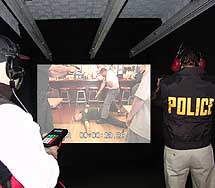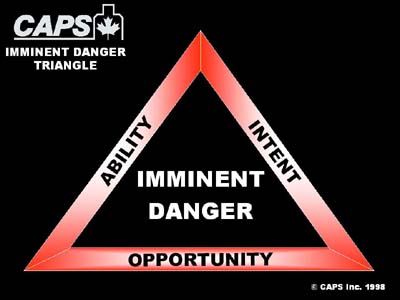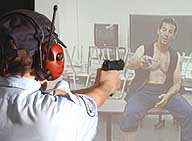
CAPS DVD Simulator
Now available through Mobile Tactics for Sale, Lease or Rent.
The CAPS System can be delivered to you in our mobile range, setup on your range, or in your classroom.




Why are CAPS simulators live-fire systems?
Only live-fire simulator training with your actual duty gun and service ammunition can PROVE your firearms and decision-making skills when under stress. Court cases have repeatedly shown the necessity for live fire training. Laser guns, air munitions and/or marking cartridges cannot accomplish this.
If live-fire training is so important why do you offer the capability of training in a classroom with plastic munitions?
Judgment training is essential for all personnel working with firearms. We enable this to be provided by using plastic bullets where a suitable range is unavailable. We do however believe that this is “cheating”. If at all possible, it is advisable to use CAPS on a live range, in order to be able to PROVE the adequacy of your training in court.
How can you supply the CAPS system at such a low cost?
The CAPS simulator is a simple system. Even though it uses the highest quality components available it does not require the large investment in Research & Development, service and repair inherent with the laser-based, computerized systems.
What is supplied with the CAPS system?
The CAPS system has a housing containing the DVD player, LCD projector, audio transmitter and receiver headset and sound system. Also supplied are the control unit, the screen frame, a roll of screen paper and the nylon screen used with plastic munitions in the classroom. The system comes with 460 scenarios and is completely covered by a one-year warranty. The CAPS control unit is covered by a five-year warranty.
Is the CAPS system computerized?
No, the CAPS system is not computerized. Computers are not rugged enough for daily use in a range environment.
How many scenarios are available for the CAPS system?
We have more than 460 scenarios presently available and are continually producing new ones. Fresh instructional material is developed on an ongoing basis.
Can we have our own custom-made scenarios?
Yes you can. If you have a video or audiovisual department you can tape your own custom scenarios. You can also hire CAPS to produce scenarios for you, using our digital camera and body-mount camera stabilization system.
How is the CAPS system used in the classroom?
In the classroom a revolver is normally used, with primer-powered plastic munitions. The back of the CAPS screen is covered with a nylon sheet which stops these rounds after they penetrate the paper.
Can I use my semi-auto pistol with the CAPS system in a classroom?
Yes you can. This requires purchase of a Simunition FX Barrel kit for the weapon in question and use of Simunition CQT (Close Quarters Training) rounds. These rounds are too fast (750fps) to stop with the nylon screen we supply for classroom use with revolvers but you can improvise a bullet trap for them out of various materials.
Do we have to modify our firearms to train with the CAPS system?
You do not have to modify any firearm to use the CAPS system with live ammunition or for use of revolvers and plastic projectiles in the classroom. For semi-automatic or fully-automatic weapons in the classroom you will have to change barrels and use specialty ammunition.
We only have access to an outdoor range. Will CAPS works outside?
Any CAPS system will work anywhere that you can provide power and control the light falling on the screen. There is no problem training at night. For daytime training the screen is placed in a dark tent with the back end left open so the rounds can exit without causing any damage.
Can we use the CAPS system for sniper training?
You can use any firearm with the CAPS system out to 100 yards. The CAPS DVD system actually has a range compensation program which freezes the image on the screen at the precise instant the bullet hits the screen regardless of range distance or bullet velocity.
Can the CAPS system be used with intermediate weapons, such as batons or pepper spray or less-lethal weapons?
Yes. The instructor can opt to pause the scenario at any time if he considers use of an intermediate weapon is warranted and the officer in training has presented it as an option instead of a firearm. There is an intermediate weapon button on the CAPS control unit for this purpose.
Does CAPS training replace three-dimensional role playing with Simunition or other marking munitions?
It does not and it should not. A proper firearms program will cover three distinct levels of training. Static level training where you learn how to draw a weapon and shoot. Dynamic level training where you prove your ability to deliver live ammunition when and where necessary, and learn to move and make use of cover while firing live projectiles. Interactive level training where you prove your ability to escalate and de-escalate your responses in fluid role-playing exercises which replicate as closely as possible the three-dimensional world in which you operate. CAPS training comes into play at the Dynamic level while Simunition training is the next step after you have proven your skills with live ammunition.
We already have a sophisticated computer-based system why do we need a CAPS system?
You need a CAPS system to allow you to PROVE your ability to deliver live ammunition when and where necessary on hostile human aggressors. Lasers, air munitions and marking cartridges cannot do this.
Can we just upgrade our laser-based system to use live ammunition?
It may be possible to upgrade a system to live-fire but you will find that this will cost two to three times the cost of a complete CAPS system. Most live-fire upgrades for laser-based systems will still require a modified gun and a semi-permanent range installation.
Aren't you afraid of having somebody shoot the simulator housing?
No. The officer in training is normally forward of the simulator housing unit. When the system is used at extended ranges a steel plate is placed between the shooter and the simulator.
What is needed to provide CAPS training?
You need a 120-volt power source, a safe backstop for the projectiles you are firing, and some method of keeping light off the projector screen.
Why is the simulator called CAPS?
CAPS stands for the "Canadian Academy of Practical Shooting" and is the name of the company that designed and builds the systems.
How does the CAPS system function?
The CAPS system is sound-activated. The microphone built into the CAPS control unit immediately pauses the image on the screen when the pre-programmed number of shots have been fired by the trainee.
How long does it take to learn to operate the CAPS system?
A one-day CAPS instructor's course is provided with each simulator, but actually the system can be operated with less than an hour's training. We have had agencies who have set up and taught themselves to use the system without any input from us.
We rent a range to train in. How portable is the CAPS system and how long does it take to set up?
The CAPS DVD weighs less than 100 pounds and is mounted in its own wheeled shipping container. The system can be completely set up in ten minutes and taken down in less than five. We have actually demonstrated the system in less than 30 minutes from arrival to departure.
What is the CAPS screen made of?
The frame of the screen is made of wood. The projection surface is a large sheet of paper. Bullet holes are immediately patched with tape, and the paper screen can last for hundreds of rounds. It is simple and cheap to replace.
What stops the projectiles that are fired at the screen?
When used with live ammunition the bullet trap or berm of the range stops the projectiles. When used in the classroom with a revolver and the plastic projectiles supplied by CAPS, a nylon screen is attached to the rear of the screen frame to stop these projectiles.
What is a body-mount stabilization system and why is it so important to scenario production?
A body-mount camera stabilization system allows the camera to move fluidly. With scenarios it is important for the trainee to feel part of the action; the smooth camera movement provided by the body-mount draws him right into the scene. As important as this camera movement is in scenario production it is essential that the camera be rock solid when the scenario reaches a point where gunfire may be required. Any movement at this stage when the trainee is firing will cause him to miss the target through no fault of his own. The body-mount stabilizer allows both the fluid movement and a rock solid platform whenever required.
Will the people projected on the screen react to my verbal commands or actions?
No, they will not react to your voice. Verbal commands are nonetheless essential, however, in establishing the threat level that you may be facing.
How do I know if and where I hit the person I fired at?
The scenario freezes at the sound of the shot, and the bullet hole in the screen indicates its accuracy. When the scenario is replayed for analysis the image again freezes at the exact frame where you fired.
How do I know if I shot before the person on the screen shot at me?
During the replay of the scenario the last five seconds of the scenario leading up to the frame where you fired your first shot are projected on the screen. If you see the flames and smoke coming from your opponents gun prior to the image freezing on the screen, he or she fired first.
Is there a provision for the CAPS system to shoot back at me while I engage the people on the screen?
No. This type of training is better suited to three-dimensional role-playing training at the interactive level using marking cartridges such as Simunition.
Click above logo to view demonstration video.
High speed connection recommended